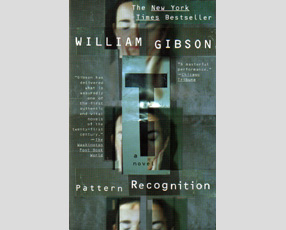Logorama, Bibendum, William Gibson: a quotation from my doctoral thesis on iconic brands, politics, and the common roots of democracy and modes of production.
Logorama, a short animated movie produced by the French Studio and Collective of Directors H5, just won the Academy Award 2010 for Best Animated Short. I posted it at werbeblogger.de [RIP] and sketched a few thoughts in my follow-up article Logophilia. Since this is all about logos, and Bibendum plays a major part in Logorama as well as in William Gibson’s Pattern Recognition, here’s a thematically related extract from my doctoral thesis’s first chapter on “Formations,” from the final section “Executive Decisions.”
In Pattern Recognition, Gibson translates the motif of dystopian corporate power into the language of a contemporary America: as a here-and-now war fought between brands and iconic images. The protagonist Cayce’s two outstanding characteristics are tied right into this. On the one hand, she is a brilliant “trend scout” freelancer, on the other, she suffers from a severe phobia of logos and trademarks:
The iconic quality of logos and trademarks prepares the ground in Pattern Recognition for an alternative approach to merge the corporate with the political. In a preparatory move, Cayce’s phobia also extends to Nazi symbols, which, additionally, plays again with motifs found in Acker’s and Pynchon’s texts which associate the fall of Nazi Germany with the rise of post-World War II’s global industry:
In “The Dig,” finally, a public and largely unorganized mass excavation on a World War II battlefield in Russia where the battle’s remains have been preserved completely intact in the mud, the corporate and the political eventually merge into the iconic, making the abovequoted “trenches obsolete”1 in the most uncanny manner:
This includes the dead pilot, found after the canopy is yanked open, who is instantly torn apart by the crowd, fighting over his watch, compass, and pistol, in a small-scale enactment of Pynchon’s “survival of things.”
How such an overlapping of corporate and political power through the power of the iconic can manifest itself in the real world, as a final example, is related by Spivak in In Other Worlds. In South Korea in the early 1980s, several hundred female workers went on strike in a factory owned by a Minnesota-based multinational corporation by the name of Control Data. After six union leaders are dismissed and imprisoned, the women take two visiting vice-presidents from the U. S. as hostages, demanding the reinstatement of their union leaders. While Control Data’s office is willing to release the women, the Korean government is not; and the dispute is ended by having the female workers beat up by the male workers at the factory, causing many injuries and two miscarriages (89). The incident as such, as Spivak concedes, is not at all uncommon within an environment of interconnections and interdependencies that revolve around former colonies, raw materials, manufacturing bases, and the western need for countries where workers can make fewer demands and governments “are mortgaged.” It also shows that “socialized capital kills by remote control” and that it “has not moved far from the presuppositions of a slave mode of production” (90–91)—at which point the “brand” enters the stage:
But the iconic, historical-symbolic value of the acronym PLATO “shares in the effacement of class-history that is the project of ‘civilization’ as such”—which is precisely the “slave mode of production” underlying the Athenian civilization that made “intellectual heights” and the birth of democracy possible, a correspondence that, as it were, is not easily dug out.
While traversing formative processes from creation myths to brand patterns by following threads of violence in the texts, the quest seems to have ended where it started: in ancient Greece. This is not an accident. The formation of Western civilization with its democracies, dialectical philosophy, and modern sciences is—two thousand years of Christian cultures notwithstanding—deeply rooted in Greek metaphysics, as are certain intuitive assumptions and metaphorical accounts about the formation of the individual in classical mythology.
If you have something valuable to add or some interesting point to discuss, I’ll be looking forward to meeting you at Mastodon!

